How to Improve Communication in Construction: 12 Ideas to Rally Managers, Teams, and Stakeholders
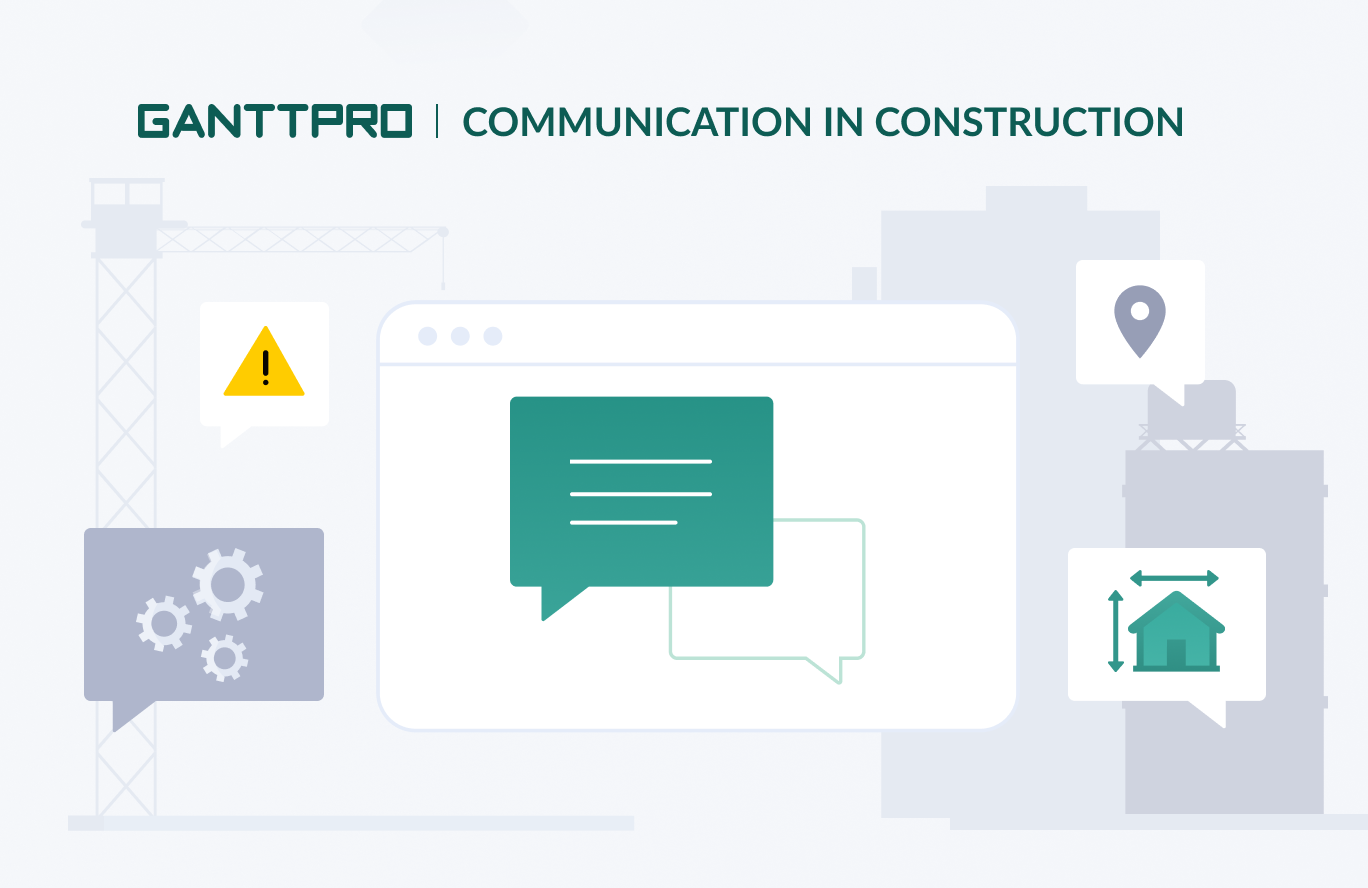
Audio version:
Solid communication is an essential part of any project. It leads to effective collaboration, improves team working skills, and results in a happy project journey for customers.
Why is communication important in construction?
A lack of communication in construction projects creates ample gaps for mistakes, including safety issues, productivity losses, financial consequences, or even construction project delays. Therefore, project managers worldwide should know how to improve communication in construction projects and make their workers a highly collaborative team.
You can find this info in any step-by-step guide to manage a construction project or read this article to explore the possible ways for maintaining effective communication and keeping projects running smoothly. In addition, you’ll find even more insights and details on this topic in other construction project management articles by GanttPRO.
Contents:
- Why is communication important in construction?
- Types of communication in construction.
- Ways to improve communication in construction.
Why is communication important in construction?
The global goal of communication in construction is to work together to find the best solutions for achieving the objectives of your project, maximizing resources, and decreasing possible costs.
The survey (2022) showed that 25% of respondents thought that “better communication” is what composed impactful construction industry technology trends.
Completing construction scope of work on time and within budget requires sharing project updates with on-site teams, liaising with suppliers, consulting with clients, and making collaborative decisions swiftly.
All workers have their own communication styles. They share information and collaborate using various tools: from a simple construction project checklist to reliable construction scheduling software. This accelerates communication and transparency and adds infinite value to the project ahead.
Construction teams rely on strong and robust communication for a number of reasons. Below is the set of proofs that reflect the importance of communication in construction.
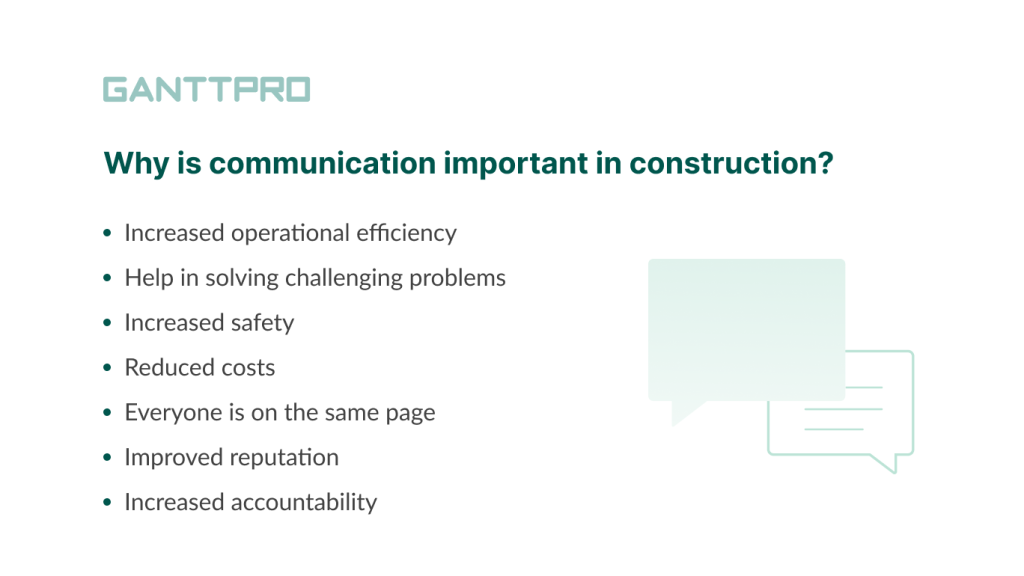
1. Increased operational efficiency
Effective communication in the construction industry helps increase productivity, streamline site processes, and reduce waste. It enhances quality control and quality assurance, helping to complete projects on time, within budget, and with better quality.
2. Help in solving challenging problems
Communication promotes a collective approach to problem-solving. When all workers and stakeholders cooperate using predefined and coordinated means of communication, they can identify problems early, develop solutions, and solve them quickly.
3. Increased safety
Work in the construction sector has many potential hazards. They include dangerous substances, work at height, on-site vehicles, etc. Therefore, one of the leading construction project management tips for any specialist on a construction site is to comply with safety standards.
When your team members constantly communicate and clearly understand their shared responsibilities for the project’s success, you can identify potential risks much faster. If communication is poor, the number of potential accidents increases. It has a direct impact on a construction workflow, morale, productivity, turnover, compensation costs, and reputation.
4. Reduced costs
Miscommunication can lead to staff turnover, higher costs for hiring new workers, increased insurance premiums, legal costs, and other issues related to resource management in construction projects. When communication in the constructor sector is efficient, and you can take advantage of construction resource management software for budget control, these problems occur less frequently.
5. Everyone is on the same page
Poor communication leads to a lack of alignment. It harms any project, as workers focus on completing different priorities.
When everyone in the team clearly understands what is expected of them, project goals and objectives are met quicker.
6. Improved reputation
Poor communication in construction may result in permanent conflicts and disruptions which can hurt the reputation of your company.
On the other hand, if you preach effective communication, your jobs are much more likely to get achieved with minimal issues and controversial points.
7. Increased accountability
The lack of information about who did what on a project can lead to headaches around claims management and problems with building safety regulations later.
Proper communication management will help you understand who completed what aspect of a job when an issue arises to reach clear accountability on your construction site.
Are there different types of communication in construction?
Types of communication in construction
- Organizational meetings.
- Desk alerts.
- Cloud-based construction management tools.
- Mobile apps.
- Wearable communication devices.
- Hand signals and other signs.
A well-chosen form of communication can significantly simplify the information exchange and boost the entire communication process.
Communication in the construction industry involves technical drawings, various meetings, and even hand signals. Daily reports, photos, videos, change orders, and requests for information can be also considered as forms of communication.
Each type of communication in construction has its advantages and disadvantages. Following them prevents the loss of information and unnecessary confusion.
Here are these types.
1. Organizational meetings
A site meeting is one of the oldest but still effective ways to manage various issues related to construction projects. This direct form of communication helps facilitate collaboration and a shared sense of purpose, making projects more likely to be completed successfully.
2. Desk alerts
Desk alerts provide information directly to any device. This internal communication channel can be seen within minutes. It allows for creating engaging content for the entire team. You may use pop-up notifications, mobile push notifications, or digital signage to send these alerts.
3. Cloud-based construction management tools
One of the critical steps towards improving communication in construction is investing in technology that can help pass significant information to construction workers. It can be any reliable cloud-based construction management tool that provides a central repository for all important data.
4. Mobile apps
Using helpful mobile applications saves time since information can reach many people simultaneously within the office and on the construction site.
5. Wearable communication devices
Modern wearable devices are also popular in the construction industry. They usually solve significant problems related to safety.
For example, smartwatches. They allow for getting a quick notification if workers start overexerting or if they need to have a rest.
6. Hand signals and other signs
It may seem trivial, but properly using hand signals and other signs on construction sites can prevent potential accidents and keep your team members safe. For example, some essential variants of this communication type include stop signals and load signals.
After the useful information about the importance of communication and its types in construction, it’s time to explore the core ways of improving communication in the office and on a construction site.
12 ways to improve communication in construction
Poor communication in construction can have severe consequences. However, there are reliable measures that companies can put in place to optimize communication and keep projects within time and budget.
Let’s dive into the list of the possible ways and tips you may follow to make communication a signature of your company. Some of the tips will be supported by comments of construction experts.
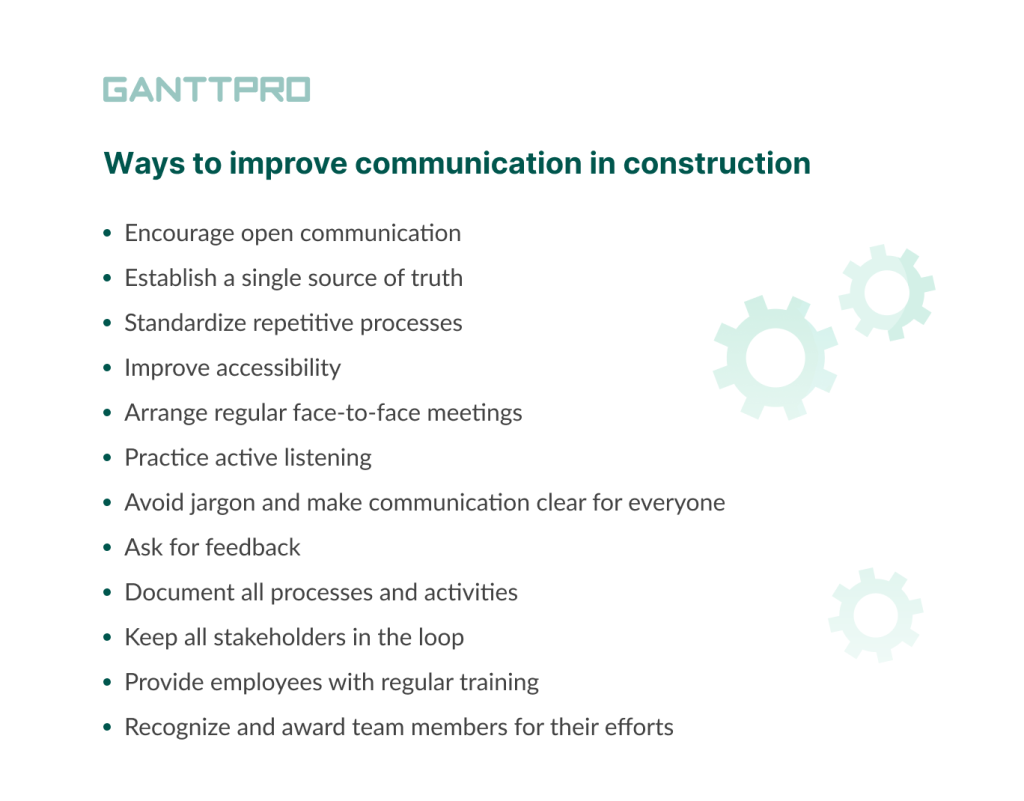
1. Encourage open communication
Communication in construction management is futile if team members don’t find it comfortable to discuss the issues with their bosses.
Open communication makes people heard and satisfied. It allows for addressing issues as soon as they arise.
Try to stay transparent and clear throughout communication acts. Avoid dominating conversations. Let your team provide their thoughts regarding new ideas and initiatives.
2. Establish a single source of truth
Adopting a multifunctional software solution that allows for the creation of a unified communication system will also help you improve the outcome of your construction project.
According to the authors of the KPMG 2021 Global Construction survey:
If all parties have access to the same software, then it will be easier and faster to move through the various stages of conceptualization, design, implementation, and even operationalization.
Many construction companies apply several tools and technologies to collect and process data. However, much of this data remains siloed. It hinders effective communication.
To streamline communication in construction management, think about creating one single source of truth for all your project information. It means that all your construction schedules, documents, financial data, designs, agreements, discussions, and other assets can be accessed from one professional platform.
Havard Haukeland, co-founder of Spacemaker and Senior Director at Autodesk claims:
Cloud-based platforms will enable better ways of communication and collaboration allowing teams to contribute anytime, from anywhere – imperative when it comes to supporting the hybrid post-pandemic workplace.
There are many reliable construction-specific and all-purpose project management platforms that can help you accelerate the effectiveness of your communication in construction.
One of the tools that receive professional awards from top software review platforms is GanttPRO.
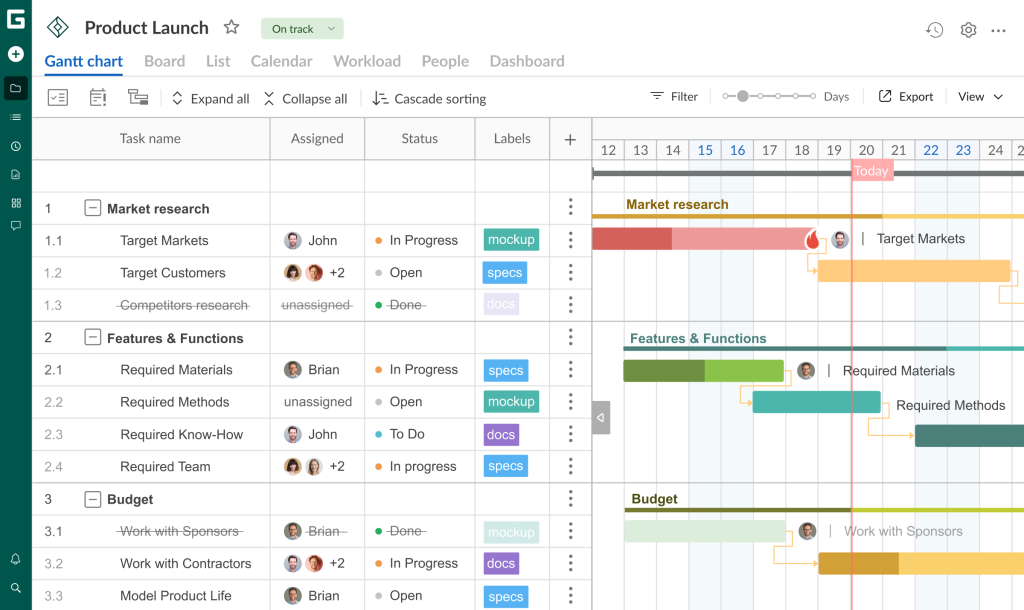
With this platform, you can not only make a Gantt chart online like a pro but also collaborate with all people involved both in the office and remotely. It serves as a good collaboration and communication helper in various types of construction management work, from engineering to building industrial objects.
Peter Stone, a project manager at KenWood Construction, LLC, evaluates the power of GanttPRO in the following way:
I was looking for software that supervisors and PMs in the field would be able to use without being overwhelmed. And GanttPRO does a pretty good job of filling that void.
GanttPRO ensures consistency, strengthens communication between stakeholders, and assists in preventing inefficiency and chaos.
You can take advantage of the tool to communicate with all the people related to your construction project.
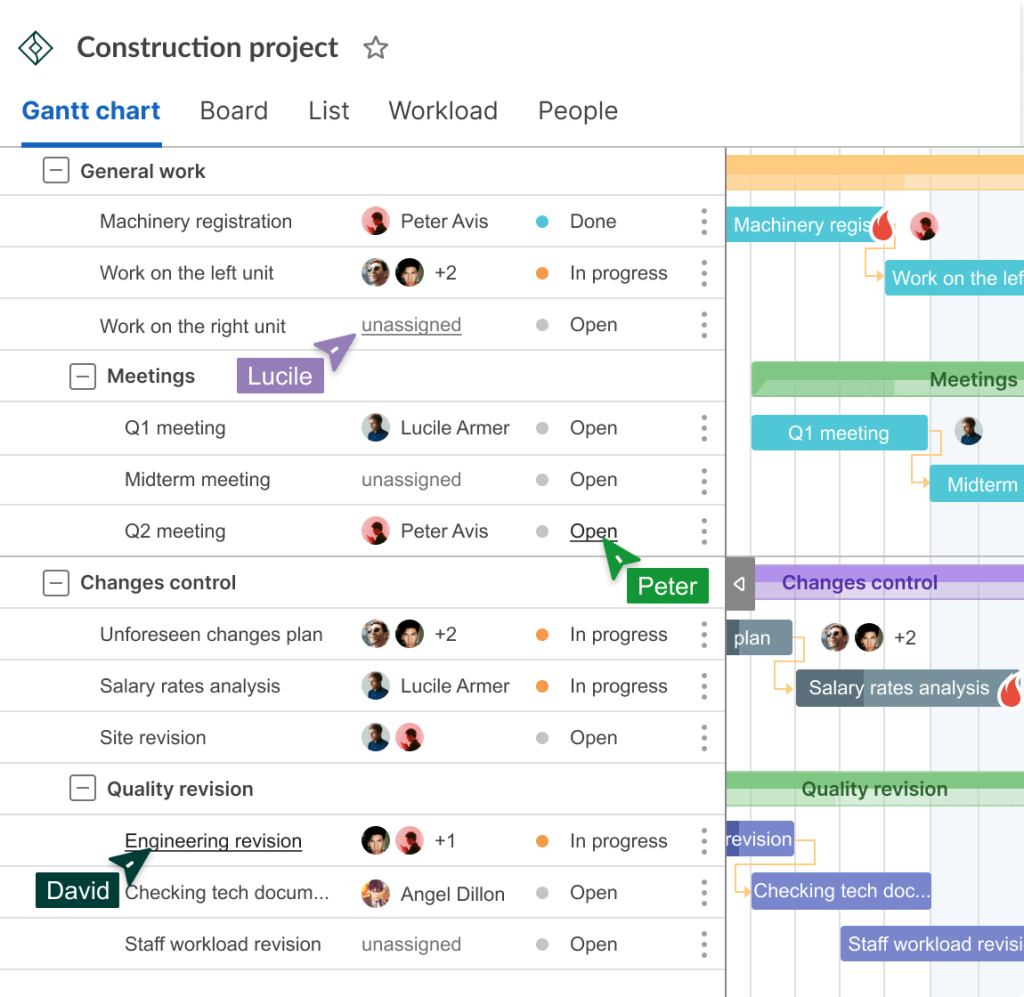
With GanttPRO, you can:
- Schedule meetings.
- Assign responsible people to different tasks.
- Leave comments.
- Add attachments.
- Receive notifications.
The platform comes with user-friendly GanttPRO mobile apps available for iOS and Android. Project managers all over the world use them to communicate while working inside and outside the office.
In addition to capabilities for advanced communication in construction, you get a range of powerful PM features including:
- Task management.
- Portfolio management.
- Resource management.
- Budget management.
- Time tracking.
- Reporting.
- Useful construction project management templates.
- Importing/exporting.
- Integrations.
3. Standardize repetitive processes
Construction projects vary in goals, size, and budget. However, their basic processes are typically the same. This also applies to communication.
If you standardize the way of working on all the projects at the site, you’ll avoid mistakes and prevent huge work pressure.
Standardization will help you identify the critical problems in communication at an early stage.
4. Improve accessibility
Construction workflows will be more clear and more efficient if you enhance accessibility in the field. Therefore it’s important to provide all your workers with immediate access to all essential operations and project processes.
With GanttPRO, you can allow your colleagues to have access to real-time planning statuses.
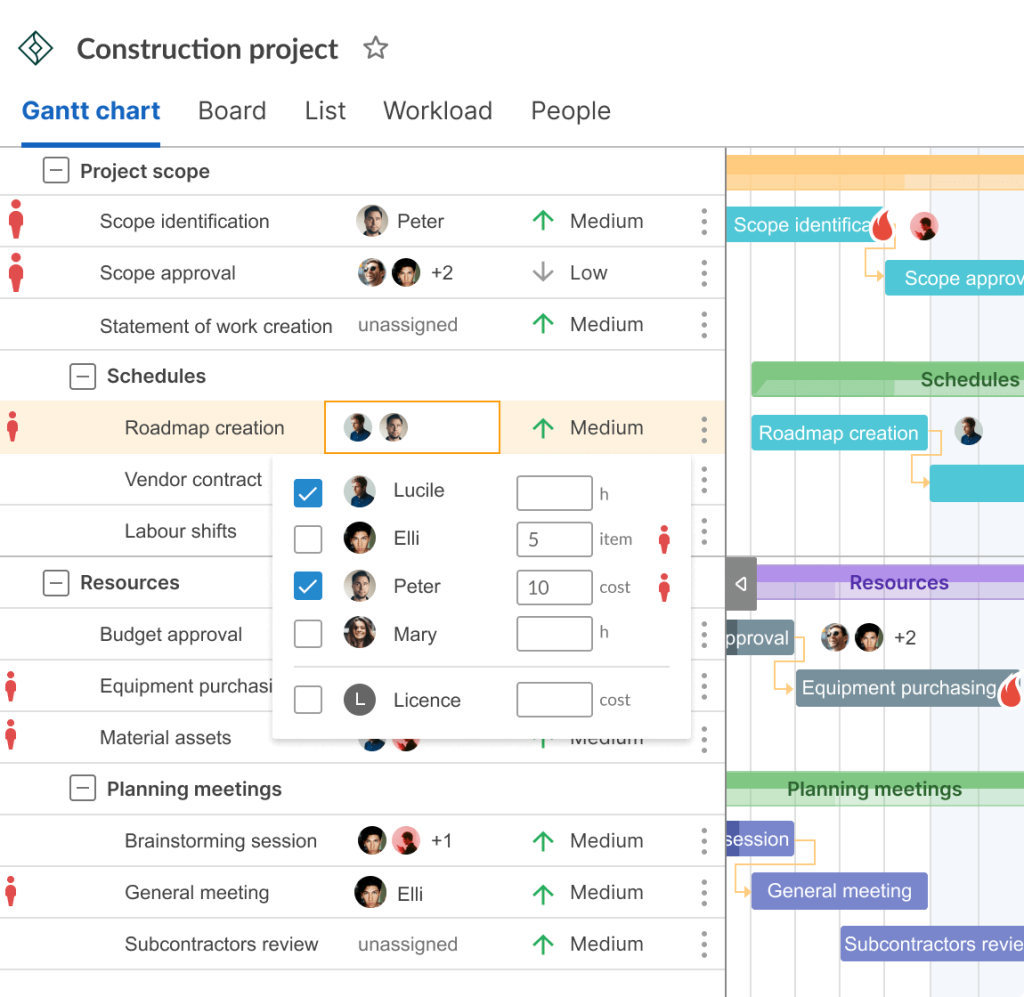
5. Arrange regular face-to-face meetings
Modern messengers, email, and quick chatting tools have revolutionized communication on construction sites. However, they don’t replace face-to-face meetings.
Constant meetings help in dealing with emotional or hot-button issues that might frustrate or anger people.
Project managers should run in-person and team meetings as often as necessary. It’s important to bring everyone together, assign tasks, assess what stage of a construction workflow the project is on, and open the door for transparent communication and timely feedback.
In GanttPRO, you can schedule all necessary meetings on a handy timeline and place them as tasks.
GanttPRO helps project teams communicate effectively and provides them with the advanced collaboration features required for professional construction project management software.
Alternatively, it’s possible to plan meetings on friendly boards.
This visual representation of your tasks and events will give you one more transparent way to schedule and manage your meetings with a simple drag-and-drop functionality.

6. Practice active listening
Colleagues can look into your eyes and nod at your words but not really listen to what you’re saying. In contrast, active listening is a far better communication method.
Active listening means a complete focus on speakers, understanding their messages, and appropriate responses. This communication skill keeps people engaged in the conversation and helps them recall essential info later.
To become an active listener, you may use a brief set of the following tips:
- Avoid noisy environments and possible distractions.
- Make eye contact.
- Demonstrate that you are relaxed and attentive (by using body language).
- Ask meaningful questions.
- Don’t interrupt.
These tips improve communication on a construction site and help you show respect to the person who is talking.
7. Avoid jargon and make communication clear for everyone
Try to avoid jargon when communicating with tradesmen, owners, and other stakeholders. Using clear and concise language will lead to mutual understanding quicker.
Remember that technical or specific construction jargon can be difficult for people outside the industry.
8. Ask for feedback
Collecting feedback from your team members will give you important insights regarding which aspects of your project run smoothly and which ones could be improved. It will let you make better decisions.
It is vital to demonstrate to workers that you value their ideas and thoughts and that their voices are heard. You can gather feedback in several ways, including employee surveys, meetings, or polls.
In GanttPRO, you can collect and store feedback in one space without losing important data.

Advanced construction management software
Plan projects on a Gantt chart and improve communication in construction.
Sign up for free9. Document all processes and activities
The documentation of processes and activities happening at the construction site also helps to boost effective communication in the construction industry.
It assists in increasing transparency and accountability that forces the contractors or subcontractors to take ownership in performing their tasks. Your documents may become a critical source of proof when any dispute arises.
The importance of documentation is well covered in an article by Insideconstruction where its authors state the following:
A document control and document management system that ensures all information is categorized, organized, approved, up-to-date, and easily accessible to stakeholders will help avoid rework, reduce costs, and deliver a greater ROI to the business at both an organization and project level.
10. Keep all stakeholders in the loop
Construction team members are often the first who know what is happening within the site. However, it’s crucial to keep other stakeholders in the loop to ensure effective communication and perform work on time.
You can use an onsite camera with live-streaming functionality that can be accessed remotely. It will let your stakeholders stay abreast of all project happenings.
Here is how this idea is supported by Hammad Chaudhry, the national director of project delivery services at EllisDon:
We now have 360-degree cameras which you can attach to your hard hat. You walk the site with it every day and automatically capture the status of that project throughout history. That means you can go back in time and see what was behind the drywall without actually ripping out the drywall.
11. Provide employees with regular training
All managers want their employees to deliver timely and quality results. Many of them try to hire specialists with advanced communication skills.
This is confirmed by Colin Rahim, the founding director and joint CEO of Growthbuilt:
We understand that the key to the success of a project is collaboration with our clients, their funders, consultants, subcontractors, and all other stakeholders. That’s why we handpick our employees with the right balance between operational outputs and client service, for their expertise, communication skills, and commitment.
Construction PMs should constantly enable workers to refresh their knowledge of existing rules and procedures and stay updated with new information, such as equipment training or site safety regulations.
By including communication skills in your training program, you’ll ensure better relationships between your workers and lower risks.
Investing in training for your team will lead to accelerating their satisfaction and making them feel valued in their job.
12. Recognize and award team members for their efforts
According to the statistics, employees are 87% more likely to stay in their jobs when they feel that their contribution is recognized and valued by the organization.
Recognize and acknowledge your team members for their hard work. Celebrate work anniversaries, birthdays, and personal achievements.
Additionally, remember to give a warm welcome to newcomers.
Improving communication in construction is the key to successful project management
Communication in construction fosters relationships between all the parties involved, keeps things moving smoothly, and helps to strengthen the bonds within teams. Without constant communication, the whole system starts to fall apart.
Fortunately, it can be improved with continuous practice and the right tools. With smart software solutions, such as GanttPRO, you can simplify your communication processes and take a significant weight off your shoulders.
Frequently asked questions about communication in construction
-
The communication skills required for managing construction projects include encouraging open communication, ability to work in a single source of truth, arranging regular face-to-face meetings, practicing active listening, avoiding jargon, asking for feedback, keeping all stakeholders in the loop, recognizing team members for their efforts, and more.
